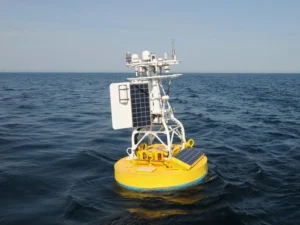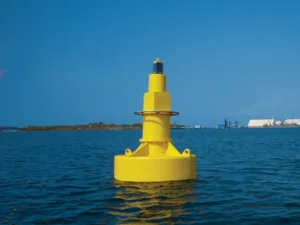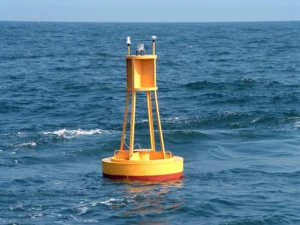Buoys are integral tools in the maritime industry. Without them, the safety of ships and vessels can be at risk. Therefore, the strength and durability of a buoy are a must. The structure and material of buoys play an integral role in their well-being.
These floating wonders act as silent sentinels. They guide and warn the vessels from a distance. If they malfunction, the chances of ship accidents can increase. Moreover, without understanding the structure, how will you maintain the buoys?
This brings us to write this comprehensive article. We will discuss the structures, materials, and properties of buoys. Ultimately, you will better understand how buoys work and what makes them reliable. So, let’s get started and explore the insight!
Overview of Buoys
Buoys are safety devices that float on water for ships’ and vessels’ guidance. They indicate warning and direction to the boats. Without these, it would be hard for boats to navigate and stay in safe areas. These floating devices have been in use for many centuries.
Several decades ago, wood buoys were used for boats and ships. Their durability was not excellent. However, they used to serve the purpose decently. However, with time, technological evolution has changed everything. The buoys and their structures are no exception.
Currently, different types of buoys are in the market. Those include navigational, mooring, and hazard buoys. Similarly, manufacturers use various materials in their making. Common materials include rubber, foam, plastics, etc. Let’s dive deep and discuss the structure of these floating devices.
What is the Structure of a Buoy?

There are many components of buoys. All of those are crucial for their proper working and functionality. Here is the list of those essential parts that make the structure of buoys.
- Hull
- Mooring system
- Superstructure
- Power source
- Communication system
Any issue with any component can affect the purpose of buoys. Therefore, engineers always check their parts. In the section below, we will discuss these components and their functionality in more detail.
1- Hull
Hull is the buoy part that floats on the water. From a distance, a portion of the buoy that remains visible to ships is called hell. This is important because it helps buoys maintain buoyancy and stability in water. Water can touch the body of this hull.
Different shapes and sizes of hell are used. Various shapes include spherical, circular, and conical. However, their purpose always remains the same. They help the buoy stay stable and buoyant in the water.
Generally, strong materials are used in the making of hulls. Due to this, the hull remains in good shape in harsh conditions. The rust, wind, or water – nothing affects their quality. It will be right that the hull is the central part that makes the structure of buoys.
2- Superstructure
Have you ever wondered how vessels see buoys at night? As you know, ships can travel day and night. In the day, the color of the hull indicates the marking. At night, the different lights on buoys indicate the navigation of the ships.
This superstructure remains outside the water. It contains lights and radar reflectors. So, the lights turn up at night due to the battery source. This helps the ships and vessels to see the warning or guidance at night. Keep in mind that this structure does not touch the body of water.
3- Mooring System
The mooring system consists of two main parts. Those are mooring lines and anchors. These two components are crucial for the stability of the buoys. The anchor goes deep into the water. It keeps the buoys at one point. No matter how strong the wind blows, the buoys won’t move.
The mooring lines or ropes attach buoys with the anchor. The strong Nylon or Polypropylene material is used in these ropes. So, they are very much capable of bearing the stress. The buoys and anchors remain connected via these ropes or mooring chains.
4- Power Source
The battery source is vital for buoys to work at night. Keep in mind that the hull of the buoys is bright fluorescent. So it remains visible for ships in the daytime. Usually, red or yellow colors are used on the upper part of the buoy. But at night, these colors are not visible to ships.
Therefore, the engineer uses lights to indicate warning and guidance to ships. The battery powers these lights. Generally, the lithium-ion batteries are used as primary power sources. During the day, the solar panels charge these batteries. The vessel sees lights on buoys and understands the warning or instructions.
5- Communication System
In the past, buoys were very simple. They were just used to indicate markings to the ships. They had no complex mechanism or functionality. However, things have changed now. The buoys now consist of sensors and radio transmitters.
The purpose of these components is to get data from the buoys. The buoys record the data through the sensors. The radio transmitter sends the data to nearby stations. It helps the engineer to track the conditions of buoys and other factors. This data can also be shared with ship pilots in an emergency for better decision-making.
What Material Are Buoys Made Of?

As I said earlier, manufacturers use different materials to make buoys. Those materials differ in terms of quality and durability. Let’s go into more detail and discuss various materials. Keep in mind these materials have different pricing as well.
1- Foam
Foam is a very lightweight material and supports buoyancy. Due to this feature, it is used in buoys. The exciting thing is that this material is also used in making surfboards. Unfortunately, foam is not ideally durable.
However, this material is affordable. So, the buoys made with foam are cost-effective. Different types of foams are used in making buoys. The common types include expanded polystyrene polyurethane and closed-cell polyethylene Foam. In the above paragraph, I mentioned that foam-made buoys are weak.
This raises a question: how does foam bear the harsh outdoor conditions? Foam-made buoys are coated with a layer of polyurethane. This barrier protects the buoys from rusting, IR rays, and salty water. So, foam-made buoys are good to go for the long run.
2- Plastics
Plastic material is another decent option for making buoys. It is not only strong but also very flexible. This feature allows the manufacturer to make buoys with different designs. Just like foam, plastic is also lightweight. When used in buoys, it ensures that the buoys remain floating without any problem.
Manufacturers employ different plastic types in buoys. Some of the common ones include Polyethylene, Polyvinyl chloride, and Nylon. Keep in mind that plastic buoys don’t need an additional protective coating. The plastic used itself is very good in protecting the buoys.
Quick Info: The plastic buoys are fragile in high temperatures. They cannot bear high temperatures for an extended duration. The high high can put cracks in the plastics. So, if you use this buoy, you’ll have to replace it after a specific time.
3- Metals
Steel, aluminum, and stainless steel are the key metals. Their usage in buoys is common. We all know that these metals, especially steel, are solid. The usage of steel in buoys makes them highly robust. They can withstand harsh conditions with ease.
There is one drawback, which is the rusting issue. As the metal remains in water, it has a high risk of getting rusted. The manufacturer puts a particular layer of paint on it to protect the metal from rusting. Even with this coating, you cannot expect them to remain rust-free for too long.
Keep in mind that these buoys are very expensive. The budget-conscious people like to avoid these metal buoys. The high pricing is due to solid metals such as steel and stainless steel. These materials are costly if you compare them to foam and plastics.
4- Rubber
It is another material that was more common in the past. However, its usage in modern buoys is decreasing. The primary reason behind its decreasing popularity is its degradation over time. However, some manufacturers still use rubber due to its low pricing.
The significant advantage of using rubber buoys is their impact absorption. If somebody hits the buoys, it doesn’t cause much damage. Moreover, Its soft surface provides a cushioning effect to boats. But their life is short, which makes it a less attractive option.
What is the Best Material for a Buoy?

It depends on many factors. However, the foam and metal are considered the most suitable material for the buoys. Foam is lightweight and cost-effective, while metal is durable but expensive. However, some people also choose plastics due to their cheap price.
I always believe in quality rather than money. So, if you ask me my opinion, I’ll recommend foam and metal buoys. They may have different price tags, but they offer durability and strength. Buoys made with such strong materials don’t need regular maintenance.
If you use plastic buoys, you’ll have to replace them after some time. This causes extra expenses. As I said earlier, plastic material starts to degrade at high temperatures. So, avoid plastic buoys in an area with hot weather.
You might be wondering why I suggested metal material. The metal buoys are solid. They remain undamaged if the boat accidentally hits the buoy. Moreover, they have a higher resistance against UV rays. So, metal buoys remain in good condition for a longer time.
Frequently Asked Questions
What is a suitable polymer for a buoy?
Polyethylene, polyvinyl chloride, and nylon are commonly used polymers. Keep in mind that every polymer has its properties. The suitability depends on the usage and preference of the manufacturer.
What is a common material used in making offshore buoys?
The common materials in offshore buoys include steel, stainless steel, and polyurethane foam. The reason is that they are solid and absorb the impact as well.
How long does the buoy last?
Foam buoys can last up to 5-10 years. On the other hand, metal buoys last 15-20 years. If you choose cheap plastic buoys, they will only last 2 to 3 years.
Conclusion
Buoys are a must for the maritime industry. They provide warning, guidance, and instruction to the pilots. Their presence indicates the parking route for the ships. However, their strength and durability matter a lot. The material used in buoys defines how strong they will be!
Therefore, we have written this dedicated guide on the structure and material of buoys. After reading this detailed article, you can identify the best material for your buoys. I recommend foam and metal for buoys. We at Jerryborg specialize in fenders. You can contact us if you have any queries.
